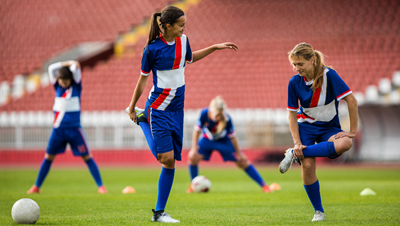Soccer ACL Injuries: Why Prevention is the Best Treatment
Orlando City Stadium was packed on opening weekend to cheer on Orlando City Soccer Club, and the Orlando Health Sports Medicine team was proud to be on the field as their official medical providers. Central Florida has fully embraced the entire team, and we’re all in awe of the athleticism our players display on the field.
But all of those kicks, twists and fancy footwork often exact a toll on soccer players’ bodies that fans don’t see.
From youth soccer to Major League Soccer, and every level in between, soccer players are susceptible to knee injuries, especially injuries to the anterior cruciate ligament (ACL). Even our hometown Lions are not immune, as injuries are inevitable when playing at all levels.
The ACL is one of four ligaments that helps to stabilize the knee joint. Soccer, football, lacrosse and basketball players often tear or sprain their ACL because these sports require a lot of cutting, pivoting and twisting activities that can make the body more susceptible to these types of injuries.
What Happens During ACL Injuries?
You can injure your ACL in several ways, including a direct hit or collision, changing direction quickly or stopping suddenly.
ACL tears often happen when an athlete lands or plants the foot while cutting or pivoting, leaving the ACL at greater risk for injury. However, a combination of environmental and genetic factors make some people more likely to be injured. Some studies have shown that women are more vulnerable to ACL injuries than their male counterparts because they typically have differences in lower extremity alignment, muscular strength and neuromuscular control, which involves the body’s ability to control movement.
With an ACL tear, athletes often will feel a “pop” in the knee that can be very painful. Symptoms typically include decreased range of motion, tenderness, pain or discomfort while walking, and swelling in the knee on the first day of the injury. If you notice acute swelling, you should seek medical attention as soon as possible. Ignoring the swelling and returning to sports or other strenuous activity that puts stress on your knee can increase your risk for further injury.
Treatment for ACL Injuries
Surgery is the most common treatment for ACL injuries, especially in young athletes. We typically perform an ACL reconstruction by using an autograft (i.e. your own tissue) or allograft (i.e. donor tissue) to repair the injury and rebuild the ligament. The graft choice depends upon the patient’s age and activity level. If we use your own tissue, we may take it from your patella tendon in the front of your knee or hamstring tendons at the back of the thigh to create a graft to reconstruct the ligament. After surgery, it takes time for the ligament to mature and get stronger, and a complex recovery process with high-level physical therapy is necessary to improve range of motion, strength and neuromuscular control to achieve a successful return to life as well as sports. Most athletes can expect to return to their sport within six to nine months after treatment.
The Orlando Health Sports Medicine team is also performing some leading-edge ACL surgery techniques. In certain situations, we can repair the patient’s own ACL tissue instead of performing a reconstruction using tissue from another area of the patient’s body, as just described. When possible, these ACL repair techniques may have the advantage of decreasing pain after surgery, decreasing the time necessary to return to all sporting activities and removing any negative consequences of having to obtain tissue from the patient’s own body to reconstruct the ligament.
Depending on your lifestyle, activity level and other injuries involving the knee joint, we may actually suggest that an operation is not the best option. We typically call people in this category “ACL copers,” because they are able to continue their normal activities without an ACL reconstruction or repair. Instead, they undergo physical therapy to maintain proper knee function.
How to Help Prevent ACL Injuries

When it comes to an ACL tear, prevention is the best approach. Athletes need to follow a sport-specific warm-up protocol before they compete. This helps increase blood flow to your joints and muscles before a game, and prepares the body for the stress of participating in certain activities. You also can practice different drills to help yourself develop good mechanics and proper alignment that protects your knees. This includes making sure you always move with your knees directly over your feet when you jump, land and stop. You also should do muscle-building workouts to develop more strength and balance in your core, hips, thighs and knees, which can provide more support during athletic movements.
Many sports also have injury prevention programs. For example, the Fédération Internationale de Football Association (FIFA), the governing body that oversees international professional soccer, created a complete warm-up routine called the 11+ program, which promotes better neuromuscular control of the knee to help prevent injuries. I encourage soccer players to follow this protocol and consider working with an experienced strength and conditioning coach to help improve mechanics and correct poor movement patterns. The Orlando Health Sports Medicine team is also performing innovative research to evaluate movement patterns in youth athletes with the goal of preventing injuries and improving performance.
ACL injuries can be very painful and scary for athletes. Playing sports requires a lot of dedication, sacrifice and commitment, so as an athlete, it’s important to do everything possible to protect your body from injury.
Surgery can be an effective treatment option after an ACL tear, but preventing the injury from occurring in the first place is always the best approach. So, warm up your muscles before game time, practice the right drills and consider having your mechanics evaluated by a specialist, especially if you have experienced a prior injury. Doing all these things can keep you on the field, instead of the sidelines!
Get a Free Guide to Prevent Sports Injuries
While exercise and sports-related activities often have a positive impact on our lives, they can also lead to serious injury. At the Orlando Health Orthopedic Institute, our multidisciplinary sports medicine team is committed to providing exceptional orthopedic care to help you return to your active, pain-free lifestyle.
Learn More







